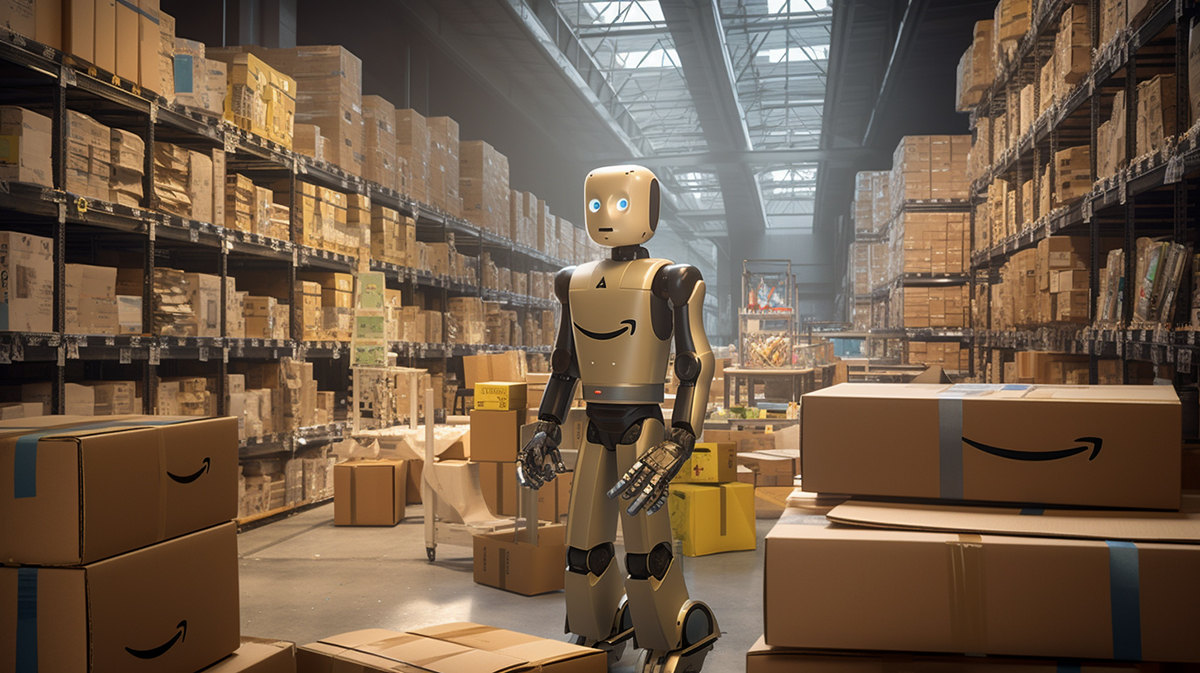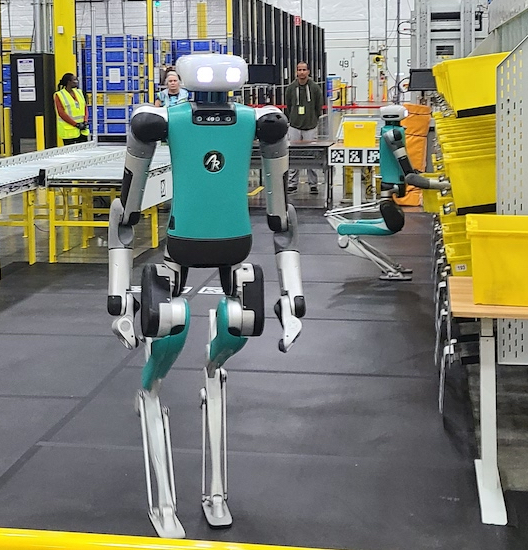Amazon's New Warehouse Wonder: Meet Digit

Agility Robotics’ latest creation, Digit, is revolutionizing warehouse operations as it undergoes testing by Amazon. This bipedal humanoid robot is equipped with advanced technology, including LED eyes, cameras, sensors, and bird-inspired legs, enabling it to navigate diverse terrains.
Its primary function is tote consolidation, which autonomously handles bulk objects like storage containers. Digit frees up human workers to focus on higher-skill jobs by handling dull, dirty, and dangerous tasks.
With plans to mass-produce over 10,000 Digit robots annually, Agility Robotics aims to continuously enhance efficiency and redefine the role of humanoid robots in the workplace.
The Background of Digit
Digit is a bipedal humanoid robot developed by Agility Robotics for warehouse work. Its design inspiration comes from bird walking patterns, allowing it to navigate various terrains with ease. This unique feature gives Digit an advantage in warehouse environments where different surfaces and obstacles are common.
Digit also boasts several other unique features, including internal antennas, LED eyes, and multiple cameras and sensors. These features enable the robot to sense, grasp, and move bulk objects like totes autonomously.
Also, Digit is equipped with a LiDAR system, which allows it to scan its environment and navigate spaces initially designed for humans.
Incorporating these design elements and features sets Digit apart from other robots in the industry. Its ability to mimic bird-like walking patterns and navigate complex environments makes it ideal for warehouse work. With its innovative design and capabilities, Digit is poised to revolutionize workplace tasks.
Digit’s Role in Tote Consolidation
Digit autonomously performs efficient tote consolidation in Amazon’s warehouses. Equipped with LiDAR scanning technology, Digit can navigate the warehouse environment initially designed for humans. The robot’s ability to sense, grasp, and move bulk objects like totes makes it valuable in streamlining warehouse operations. By autonomously handling totes, Digit reduces the need for human intervention in this repetitive and time-consuming task.
Reducing human intervention increases efficiency and allows human workers to focus on higher-skill and lower-risk jobs. Digit’s autonomous tote handling capabilities and LiDAR scanning technology make it an invaluable addition to Amazon’s warehouse workforce.

Benefits of Using Digit in the Workplace
With its autonomous capabilities and advanced technology, Digit’s presence in the workplace offers numerous benefits for improving efficiency and allowing human workers to focus on higher-skill, lower-risk tasks.
By performing dull, dirty, and dangerous tasks that humans shouldn’t be doing, Digit reduces the labor required for these activities. This frees human workers to concentrate on more complex and creative tasks requiring expertise.
Additionally, Agility Robotics plans to mass-produce Digit robots, which can further enhance warehouse efficiency by increasing the number of tasks that can be automated. Digit’s walking speed, intentionally designed to be similar to that of humans, ensures seamless integration into the work environment. The continuous improvement of Digit’s motion quality also contributes to greater efficiency in the workplace.
Testing and Employee Feedback
During the early stages of testing, Amazon values employee feedback on using Digit in real-world warehouse environments. The company recognizes the importance of employee satisfaction in ensuring the success of this new technology. By actively seeking feedback from warehouse employees, Amazon aims to address any concerns or challenges that may arise during the testing process.
This feedback allows Amazon to improve and optimize Digit’s performance to enhance warehouse efficiency. By involving employees in the testing and development of Digit, Amazon demonstrates its commitment to creating a positive work environment and ensuring that the introduction of robotic technology aligns with the needs and experiences of its workforce.
This iterative approach to testing and employee feedback reflects Amazon’s dedication to continuous improvement and innovation in robotics.
Concerns and Future Implications
As the use of humanoid robots like Digit continues to evolve, questions arise regarding the potential impact on human employment and the future implications of this technology. One of the main concerns is the ethical implications of replacing human workers with robots. While Digit can perform dull, dirty, and dangerous tasks, it raises alarm bells about job displacement and the potential loss of livelihoods for human workers.
Additionally, there are doubts about the long-term viability of humanoid robots like Digit. How well they can adapt to changing environments and handle complex tasks remains to be seen. Furthermore, the cost of implementing and maintaining such robots may pose challenges for businesses.
Despite these concerns, the development of robots like Digit aligns with the ongoing evolution of labor towards higher-skill, lower-risk jobs.
Digit’s Unique Form Factor
Digit, a bipedal humanoid robot developed by Agility Robotics, is unique in Amazon’s warehouses because of its unique form factor. Digit’s appearance resembles a humanoid robot with a sleek and futuristic design. It is approximately 5 feet tall and has a slim and agile build.
The robot’s design features include internal antennas, LED eyes, and multiple cameras and sensors, which enable it to perceive and interact with its environment. Digit’s legs are inspired by bird walking patterns, allowing it to navigate various terrains with ease. This unique form factor gives Digit a visually appealing appearance and enhances its functionality and adaptability in warehouse settings.
With its distinctive design and advanced features, Digit is poised to revolutionize how tasks are performed in Amazon’s warehouses.
Amazon’s Continuous Innovation in Robotics
Amazon’s commitment to pushing the boundaries of robotics in its warehouses is evident in its continuous innovation efforts. The introduction of robots like Digit is just one example of its dedication to improving efficiency and productivity. Digit’s ability to perform dull, dirty, and dangerous tasks allows human workers to focus on higher-skill, lower-risk jobs.
This continuous improvement in robotics not only benefits Amazon but also has future applications in various industries. As technology advances, we can expect to see more sophisticated robots capable of handling complex tasks. The development of robots like Digit aligns with the evolution of labor towards higher-skill jobs, and while concerns about the impact on human employment exist, Amazon’s testing and commitment to gathering feedback aim to address any concerns and ensure a positive employee experience.
Impact on Human Employment
Robots like Digit can significantly impact human employment in the warehouse industry. The introduction of automation in warehouses raises concerns about job displacement. As robots like Digit become more advanced and capable of performing tasks that humans traditionally did, some jobs may no longer be necessary.
However, while automation may lead to job displacement in some areas, it can also create new job opportunities. For example, implementing robots like Digit may require technicians and engineers to maintain and repair the machines. Additionally, humans can focus on higher-skill tasks that require creativity, problem-solving, and decision-making.
It is crucial for companies like Amazon to carefully consider the impact on human employment and ensure that adequate measures are in place to support and retrain affected workers.
Frequently Asked Questions
How Does Digit’s Lidar System Work and How Does It Help the Robot Navigate Its Environment?
Digit utilizes a LiDAR system to scan its environment. This system allows the robot to create a detailed 3D map and accurately detect obstacles. By analyzing this data, Digit can navigate complex environments autonomously and safely.
What Specific Tasks Can Digit Perform in a Warehouse Setting Besides Tote Consolidation?
Digit can perform inventory management, item retrieval, and order fulfillment tasks in a warehouse setting. While it can improve efficiency, limitations may arise from its ability to handle delicate or fragile items.
Can Digit Interact With Humans in Any Way, or Is It Strictly a Machine That Operates Autonomously?
Digit is primarily designed to operate autonomously in a warehouse setting. While it cannot interact with humans, its collaboration with humans in tasks like tote consolidation can have a positive impact on productivity.
How Does the Development of Digit Align With Amazon’s Overall Goals and Strategies in the Robotics Field?
Digit’s development aligns with Amazon’s goals and strategies in robotics by improving efficiency and safety in warehouse operations. However, the use of humanoid robots raises concerns about human employment implications.
What Are Some Potential Long-Term Implications of Using Humanoid Robots Like Digit in the Workplace, Both in Terms of Job Displacement and Employee Experience?
The potential long-term implications of using humanoid robots like Digit in the workplace include job displacement and changes in employee satisfaction. While robots can perform specific tasks more efficiently, human workers may need to transition to higher-skilled roles to maintain employment.
Digit, the bipedal humanoid robot developed by Agility Robotics, has the potential to revolutionize warehouse operations by handling dull, dirty, and dangerous tasks. With advanced sensors and navigation capabilities, Digit can autonomously navigate diverse terrains and perform tote consolidation tasks.
By freeing up human workers to focus on higher-skill jobs, Digit’s incorporation into the workplace can enhance efficiency and productivity. However, concerns and future implications surrounding using humanoid robots like Digit need to be carefully considered and addressed.



